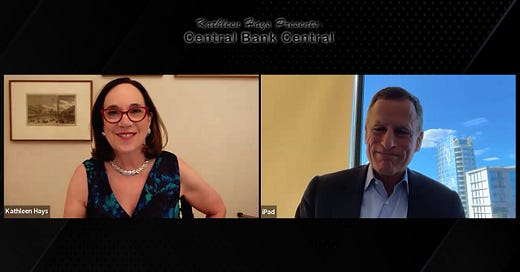Kaplan Backs Jobs-Boosting Fed Rate Cuts: Sticky Inflation May Limit Future Moves
Former Dallas Fed President Says 100bps Drop in Key rate to 4.25-4.5 is Right for Now
Rob Kaplan, former president of the Federal Reserve Bank of Dallas, is firmly on board with the Federal Reserve’s decision to embark on its long-awaited rate cutting path with a larger-than-usual and therefore more aggressive 50bps rate cut. He sees it making up for the Fed not starting on this path at its July meeting with a 25bps cut.
In fact, he was calling for this well before the FOMC reached its decision on Wednesday.
“It was my view that with inflation running around 2 .5 % and a labor market at least stabilizing, that the right Fed funds rate over the next four to six months, is probably in the neighborhood of four and a quarter, four and a half percent,” he says.
“If you could take a clean sheet of paper, that's where I'd want to set the Fed funds rate, he says. “That's high enough that you're still restrictive and fighting inflation. But I think the Fed does not need to be at five and a quarter, five and a half, and we risk undue weakening in the labor market.
Rob says it was important to make clear in the press conference that future action will be more moderate, giving the Fed to both address “the labor force weakness, still be fighting inflation, but keep all their options open through the fall, depending on how inflation behaves.”
”If they had done 25 bps they would have had to commit or telegraph that they were gonna do more in the future, he adds, being reactive, chasing the economy “instead of being on their front foot.”
As for what’s next, “if you look at this with a clean sheet of paper and say are we happy with where the Fed funds rate is, the answer is no, “ Rob says. “We're materially higher than where we need to be to get inflation probably from two and a half down to two.”
He says that is was necessary to move the key rate higher but now it’s 75 to 100 bps than where it needs to be and that’s why “the first phase of rate cutting will be, I wouldn’t say easy, but I think is clear.”
What will be difficult for the Fed as it cuts rates? If inflation is sticky at 2.5% to 2.6%
“I would be reluctant to move below four and a quarter, four and a half until I saw that improvement below two and a half. And that's where the tension will come,” he says.
In fact, Rob sees a “distinct possibility, if not probability, that inflation is going to be sticky here around 2.5, 2.6 percent happen. It’s very possible.” That’s why if were at a Fed official “I’m taking up one meeting at a time, and and I’m not committing to anything on what I’m going to do in November December or certainly beyond January.“
Rob laid out his estimate of the neutral rate and how this informs his view that at this point the Fed funds rate needs to stabilize around 4.25%-4.5% He sees the current neutral fed funds rate of 2.75% to 3%. “But if inflation is sticky, neutral for me is 3.25% to 3.25%.”
“I know some have said we need to get to neutral. I'm not one of them, because I don't think it's appropriate to get to neutral until we see progress on inflation from 2.5% down to 2.0%,” he adds.
Progress has been made to the Fed’s 2% target, and with the neutral rate at 3-3/4% I think being 100 basis points restrictive feels to me — these are all judgment calls - feels to me to be about right,” he says.
“I'm very conscious of the fact the war on inflation is not over yet,” Rob adds.
“And there's a distinct possibility that service sector inflation will be sticky. So no, I want to preempt, if I can, further labor market weakening, but no, I have not declared victory yet on inflation.”
We looked at how the division between Fed officials who are still worried about inflation being too high, like Fed governor Mickey Bowman who dissented against the 50bps rate cut in favor the 25bps move — the first dissent by a Fed governor since 2005! Are the markets properly reading the signals the Fed correctly?
.
Moves in the the debt markets “are pretty optimistic that the Fed is gonna be able to see its way clear not only to do the first hundred basis points, but to do the good part of the second hundred basis points. Will that turn out to be the case? I don't know,” he says.
We discussed how fiscal stimulus is still flowing into the economy and will continue to do so next year, how the cost of financing it via the bond market will affect long term rates and therefore bond yields and mortgage rates,
And much more, like where this Texan former Fed official sees the energy market going. Spoiler alert: sustainable source of energy are growing rapidly in the Lone Star State, good for sustainability, and even so there will be many more years ahead of fossil fuels being an important part of the industry and economy.
Hear and see what Rob has to say. There is so much here. Above all his analysis and understanding of where the Fed is now, and importantly what he thinks the Fed must do now, are priceless. Agree or disagree, you will glad you have heard what he has to say.




